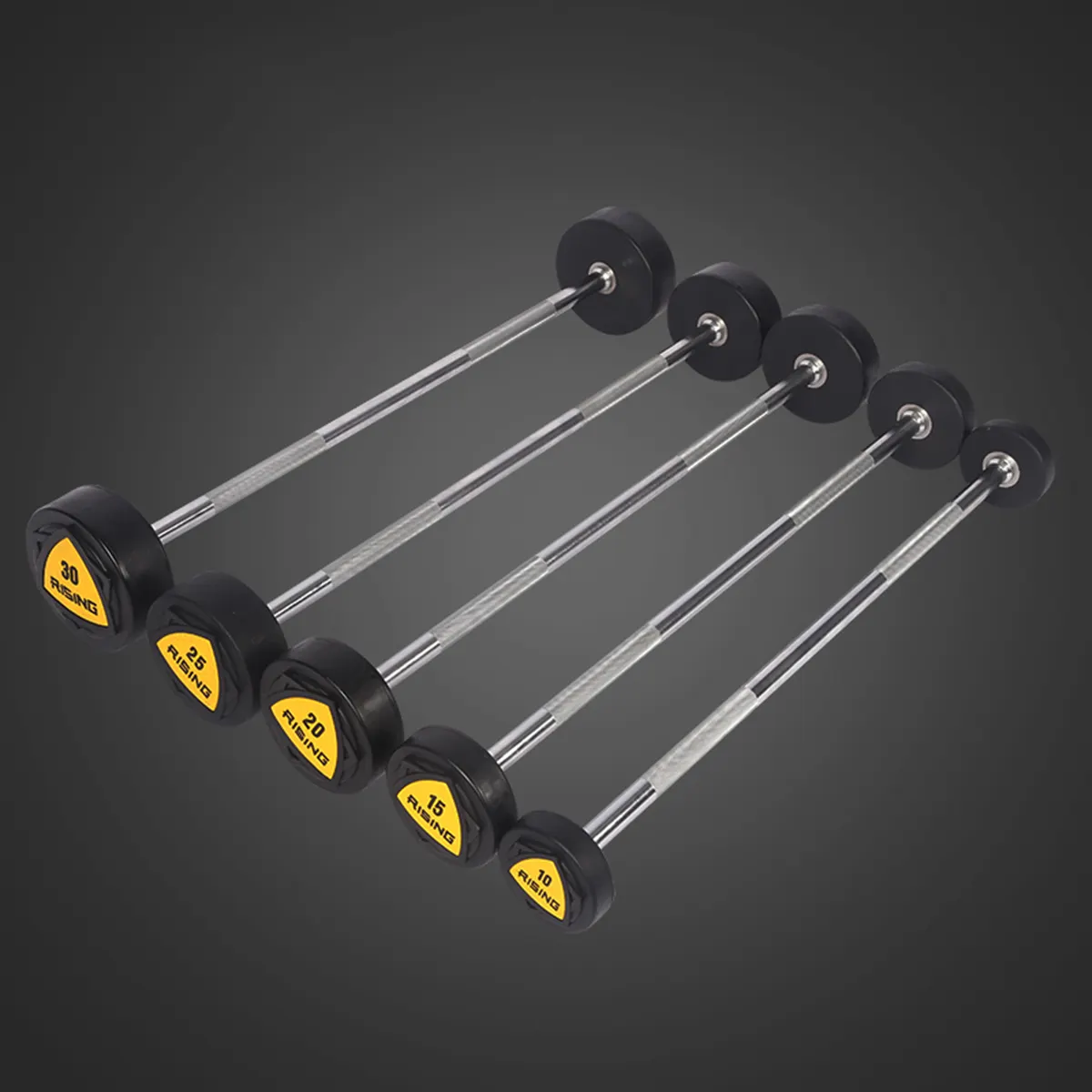Understanding Fixed Barbell Workouts
What Makes Fixed Barbells Unique?
Fixed barbells really stand out when it comes to strength training since they keep the same weight throughout exercises. This makes it easier for people to focus on how they're moving rather than worrying about adjusting weights all the time. Free weights change weight depending on what plates get added or taken off, but with fixed barbells lifters can just work on getting their form right. The consistent weight helps athletes nail down those movements properly, which cuts down injuries and means workouts actually count for something instead of being wasted effort.
Fixed barbells give users a set range of movement that helps target certain muscles better than free weights often can. The way they work allows people to really focus on their form during workouts, which makes them great for exercises aimed at specific muscle areas. Take bicep curls or tricep extensions for example the fixed path keeps the movement consistent so the right muscles actually get worked properly. Bodybuilders especially appreciate this feature because getting those defined lines requires precise training techniques. Even pros who need maximum efficiency from every rep find fixed barbells invaluable when building detailed muscle definition across their physique.
These barbells come with an ergonomic shape and fixed grips that work well for most people who lift weights. People come in all shapes and sizes, but thanks to how they're designed, folks from beginners to experienced lifters can get a good grip without struggling. That means gyms big and small can stock these bars knowing almost anyone will find them comfortable to use. Home workouts become easier too since there's no need to worry about adjusting equipment for different users.
Core Benefits for Strength Training
Fixed barbells bring something really valuable to strength training: rock solid stability when lifting. When the bar doesn't move around unexpectedly, people can actually handle heavier loads without worrying about safety issues. This makes them great for everyone from beginners who need extra control to advanced lifters pushing their limits. The stability factor isn't just about avoiding accidents either. Over time, working with these bars helps build real strength gains while also boosting confidence levels. Many gym goers notice they feel more secure throughout their workouts, which translates into better form and ultimately better results across different exercises.
For beginners, fixed barbells are a game-changer as they facilitate easier learning of complex movements. Weightlifting can be intimidating, but with fixed barbells, new lifters can focus solely on mastering their technique without worrying about adjusting weights. This straightforward approach demystifies strength training and makes it accessible for novices.
Fixed barbells remain important for building bigger muscles because they offer consistent weight throughout each set. When compared to other types of weights where the load might change between reps, barbells keep things stable so muscles get properly worked out session after session. That kind of reliable resistance really matters when trying to grow stronger and bigger. For people who want real gains in their physique, investing time into learning proper form with barbells makes all the difference in long term progress.
Essential Fixed Barbell Exercises for Strength
Squats and Deadlifts: Foundational Moves
Squats and deadlifts form the bedrock of most strength training programs. Doing squats with a standard barbell hits several key areas at once - think quads, hamstrings, those big butt muscles we all want to strengthen. The magic happens when these different muscle groups team up during the movement, creating stability throughout the entire lower body. Proper form becomes second nature after a few weeks of practice, which makes maintaining good posture during daily activities much easier too.
Deadlifts done with a standard barbell really work out multiple muscles at once. Most people find that their back, hips, and core get a solid workout during these lifts, which helps them learn how to lift correctly. Good form is super important here since it builds both core stability and overall back strength. When using fixed weights, there's less chance of losing balance or getting distracted, making it easier to focus on form details. Some folks like adding variations like front squats or Romanian deadlifts after they've mastered the basics. These changes keep things interesting and stop progress from hitting a wall. Anyone serious about building strength should definitely include these basic moves along with some variations in their routine if they want to keep getting stronger without plateauing.
Overhead Press Variations
The overhead press using fixed barbells is a pivotal exercise for building upper body strength. This movement primarily targets the shoulders and triceps, with secondary engagement from the core and upper chest, enhancing stability and muscle coordination.
Incorporating variations like the seated overhead press can significantly improve muscle activation while minimizing injury risks by stabilizing the body; this variation isolates muscle groups effectively, allowing for controlled and progressive overload.
Integrating fixed barbell presses into a regular training routine enhances functional fitness, which is vital for everyday activities such as lifting and reaching. Additionally, fixed barbells simplify weight management, enabling effortless transition between different exercises.
Proper Technique for Fixed Barbell Safety
Grip and Posture Fundamentals
Getting the basics right about how to hold and position yourself during fixed barbell exercises makes all the difference in staying safe and getting results. Grip width matters a lot because it affects which muscles get worked and how much stress goes on the joints. Take bench presses for example. When someone uses a wide grip, their chest muscles really kick in, but if they go too narrow, those shoulder joints start feeling the burn pretty quick. Most lifters find that adjusting grip based on what feels comfortable yet challenging works best for long term progress without injury.
Getting into the right position while lifting matters just as much as anything else. Good posture keeps everything stable and helps generate more strength when weights get serious. Take squats and overhead presses for instance poor form here often leads to back problems down the road. Many lifters find standing in front of a mirror really helps them spot mistakes they didn't realize they were making. Looking at how their body looks mid-lift allows quick corrections without needing someone else around to watch.
Avoiding Common Lifting Errors
Avoiding common lifting errors is key to ensuring safety and effectiveness in workouts involving fixed barbells. One of the most frequently observed mistakes is rounding the back during exercises like deadlifts, which can lead to severe injuries. Instead, maintaining a neutral spine is recommended to support proper form.
Another crucial aspect is using lighter weights to hone technique instead of immediately opting for maximal loads. This approach not only reduces the risk of accidents but also fosters better long-term strength development.
Lastly, for those who are new to lifting techniques, engaging a spotter provides an additional layer of safety and confidence. A spotter can offer real-time feedback and ensure youâre executing each movement correctly.

Designing a Fixed Barbell Workout Routine
Sample Full-Body Program
Designing an effective full-body workout routine with fixed barbells encompasses various fundamental exercises to ensure balanced muscle development. A comprehensive program should include exercises like squats, deadlifts, bench presses, and rows to target multiple muscle groups efficiently.
Tailoring these movements into sessions with specified rep ranges, such as 8-12 repetitions per set for promoting hypertrophy, maximizes strength and muscle gains. Additionally, progressing the routine every 4 to 6 weeks by introducing heavier weights or substituting exercises can help counteract adaptation, thus encouraging continuous improvement.
Progression Strategies
Implementing progression strategies is vital for muscle growth when working with fixed barbells. Utilizing progressive overload by gradually increasing weights or incorporating additional sets works wonders in driving muscle adaptation and strength enhancement.
Adding supersets or drop sets to workouts works great for increasing intensity while saving time at the gym. Many lifters find that keeping track of their sessions in some sort of journal makes all the difference. It keeps them motivated when they see improvements over time and lets them tweak what's working versus what needs changing. Without proper records, it's easy to get stuck in routines that aren't actually helping reach those fitness targets.
Why Fixed Barbells Excel for Strength Goals
Stability Advantages Over Free Weights
Fixed barbells provide significant stability advantages over free weights, making them an ideal choice for those focusing on strength goals. This inherent stability minimizes the need for balancing skills typically required with free weights.
Lifters get to focus entirely on building strength when they don't have to worry about stabilizing weights during exercises. Studies done in lab environments show fixed barbells often activate muscles more than free weights do. The advantage here is pretty clear for anyone wanting to hit specific muscles hard without sacrificing good technique throughout each rep.
Progressive Overload Made Simple
The simplicity of progressive overload with fixed barbells is a standout feature, especially for beginners aspiring to achieve strength goals. Adjusting weights on fixed barbells is straightforward, removing the complexities of handling multiple plates.
This ease of weight selection encourages consistent progression, allowing lifters to focus on incremental improvementsâcrucial for long-term success in strength training. Regularly updating training programs to include heavier weights adheres to the progressive overload principle, ensuring continuous muscle growth and strength enhancement.
This simplicity not only aids consistency but also helps in setting achievable targets, fostering motivation.
Frequently Asked Questions
What are fixed barbells?
Fixed barbells are weightlifting tools that have a consistent weight. Unlike free weights, the weight of a fixed barbell does not change during exercises, allowing for more focus on technique.
Are fixed barbells suitable for beginners?
Yes, fixed barbells are ideal for beginners. They require no adjustments to weight, making it easier to learn proper form and build confidence in lifting.
Why are squats and deadlifts considered foundational exercises with fixed barbells?
Squats and deadlifts engage multiple muscle groups and promote balanced lower and upper body strength, making them essential for a comprehensive strength workout.
How do fixed barbells contribute to muscle hypertrophy?
Fixed barbells ensure consistent loading patterns, consistently challenging muscles and promoting significant hypertrophy over time.
Are fixed barbells safer than free weights?
Yes, fixed barbells offer enhanced stability during lifts, reducing the risk of injury while promoting greater focus on muscle engagement.


